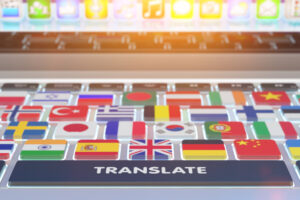Note: This blog post was originally written in Japanese for our Japanese website. We used our machine translation platform Translation Designer to translate it and post-edit the content in English. The original Japanese post can be found here.
In this post, we'd like to touch on the advantages of machine translation in response to the popularity of our blog series of Machine Translation Vs. Human Translation. We had part 1, part 2, and this post will be extra edition 1.
| For those who missed it, check out the series here: Machine Translation Vs. Human Translation Part 1: Are We Being Replaced? Machine Translation Vs. Human Translation Part 2: When Are They Effective? |

How good is machine translation?
Before we dive into the topic, let's recap what we shared before. In part 1 of the series, we discussed the superiority of human translation from three perspectives after sharing our view that professional translation services won't go out of business.
In part 2 of the series, we compared the types of documents that are suitable for machine translation and suitable for human translation according to different situations.
There are advantages and disadvantages to both machine translation and human translation. However, since we introduced mainly the advantages of human translation in part 1 of the series, we received feedback asking about the advantages of machine translation and if it's worthless or not.
Probably, everyone is wondering if machine translation will ever see the light of day. But that's not true! In this post, we're going to discuss the superiority of machine translation from the viewpoint of quality, cost, and delivery.
Quality
First, let's touch on how quality is different when comparing the two. The human translations that we talk about here are services provided by professional translators who can make a living with just translation work and are constantly making efforts to improve their skills.
Given that, we can probably say that the quality of machine translation is inferior to that of human translation in most cases.

Some of you may have thought, "What? Then it's better to get human translation!" Yes, that's right. If you only look at quality, the answer is that human translation is better. But adding the concept of cost will change that answer.
There is basically a trade-off between quality and cost, and high-quality translations generally cost more. For example, if you're creating a document for a public announcement such as a CEO's message or a press release, you need sophisticated writing because it will directly link to the corporate image. In this case, spending money on translation makes sense.
However, if you want to translate a document just to use the material as reference, is it really necessary to have high-quality translation such as meticulously adjusting the tone and style and keeping the consistency in terminology? Of course, from the standpoint of readability, good quality is always better, but what if it costs twice or three times more? Is it worth it? Depending on your budget, we bet the answer will be no.
Therefore, when cost is as important as quality, machine translation often has more advantages.
Similarly, when considering quality and delivery, it can be said that there is a trade-off between high-quality translation and turnaround time. For example, you want to avoid spending so much time on translation if you have an urgent project and want to understand the material in the shortest time possible. Spending time on translation means less time for you after receiving the translated material.

Considering this situation, it can be said that there are also many cases where machine translation has advantages from the viewpoint of quality and delivery.
Cost
In terms of quality, we mentioned that machine translation can have more advantage by combining the factor of cost or delivery or both factors. On the other hand, machine translation has an advantage in terms of cost alone.
If you plan to use the machine-translated material as is, the cost will naturally be lower. Also, even if you take the machine translation with post-editing approach, i.e., having editors modify errors in the machine translation output, it tends to be relatively low-cost compared to human translation.
The cost reduction effect of post-editing work ranges in different levels. However, since it is relatively low-cost than human translation, machine translation is a better option if you only look at cost.
Delivery
Next, let's consider delivery, or turnaround time. Even for this factor, machine translation obviously has more advantage as well as the cost.
The advantages are similar to cost. If you use the machine translation output as is, you can obtain the translation immediately. Even if you add post-editing work, the turnaround time is still relatively quick.
Let's say we need a document translated from Japanese to English. By using the machine translation output, you don't have to write English sentences from scratch. But the downside is that you will be required to spend a longer time reviewing the translations than usual. However, even if you take the longer review process into consideration, the overall turnaround time tends to be relatively short.
We were able to reduce the turnaround time to one-fifth of the human translation when working on a project for a manual consisting of thousands of pages. Although there is a range depending on the project, you can expect to reduce the turnaround time to a certain degree. Because of this, we can say that machine translation has an advantage over human translation for the delivery factor.

Is "machine translation with post-editing" always better?
By this point, you probably get that machine translation has advantages if you consider quality, cost, and delivery from multiple aspects.
But not everything is perfect. If you are applying post-editing work to the machine translation output and are thinking of outsourcing it to a translation company, you should keep in mind the following.
When you request post-editing services to a translation company, usually there is a minimum charge in addition to some restrictions on the turnaround time, such as taking time to confirm the editors. Therefore, if you have only a small amount to translate, you won't see the advantages in terms of cost and delivery. With that said, "the larger the translation amount, the greater the advantages" is what we all should understand when considering machine translation with post-editing services.
As we conclude our post on the superiority of machine translation in terms of quality, cost, and delivery, we hope that everyone can take advantage of machine translation and get their daily translation work done in a more efficient and labor-saving way.
For extra edition part 2 of the series, we will discuss about how to convert the mindset of "machine translation vs. human translation" into "machine translation plus human translation." We will be focusing on how to make good use of machine translation combined with human translation.
Until next time!

Kawamura's translation services
Demand for machine translation with post-editing (MTPE) services is increasing more and more. With MTPE services, we make the best use of machine translation output to provide cost effective translations.
Machine translation is the fastest and the most low-cost solution, but without any editing work, its quality may be insufficient for your translation purposes. By adding the post-editing process, our linguists will edit the content and adjust the translations so that the quality is closer to what you're looking for.
Although, we must say that machine translation with post-editing is not suitable for all contents and documents. Yet centering around localization, marketing translation and mass media translation work pretty well with post-editing. With the evolution and development of machine translation engines, the skills required of post-editors are gradually changing as well. We definitely have to keep an eye on the trends in machine translation and post-editing.
Kawamura has been taking on machine translation with post-editing projects from early days. Our post-editing service is backed by the knowledge gained from numerous projects and our experienced post-editors. We have professional post-editors who we can rely on for delivering accurate Japanese translation. Moreover, we can assign native-speaking post-editors for other Asian languages, European languages, and more.
Every year, we are getting more and more requests for post-editing services in many languages, not limited to just English and Japanese. Let us offer you various solutions for any kind of requests or issues you have. Feel free to contact us for a quote or any questions in general.
_CMYK_OL.png)

